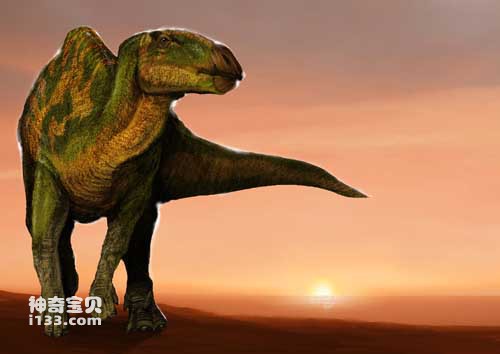In 1999, senior engineer Li Daqing of the Paleontological Research and Development Center of the Third Institute of Geological Survey of Gansu Province led scientific researchers to conduct a field investigation in the Lanzhou Basin of Gansu Province. They discovered a little outcropping of rocks in the Early Cretaceous rock strata near the top of the mountain. The bones look like dinosaur ribs. As the rock was lifted layer by layer, a relatively complete dinosaur vertebra fossil appeared in front of the scientific researchers. Their first impression at the time was that it was huge, with a rib nearly one meter long. Everyone was very surprised, but no one was sure what kind of dinosaur this was. A total of about 100 skeletal fossils were collected during this field expedition, including a complete mandible, mandibular teeth, maxillary teeth, a sternum, a phalange, multiple ribs, and parts of cervical and dorsal vertebrae.
Subsequently, these bone fossils were transported to Beijing and sent to the Institute of Geology of the Chinese Academy of Geological Sciences. After preliminary bone repair, researcher You Hailu, who specializes in dinosaur research, began to analyze and study them. At that time, Youhailu initially judged it to be an ornithopod dinosaur based on the shape of the tooth fossil, because the teeth of this dinosaur were very different from those of other dinosaurs such as theropods. The teeth of carnivorous theropod dinosaurs are usually sharper, like knives. Similarly, the tops of the teeth of herbivorous ornithopod dinosaurs generally have a worn cross-section due to long-term grinding of plants. The tooth fossils sent over obviously belong to the latter.
But what puzzles You Hailu, who has been engaged in dinosaur research for many years, is that these tooth fossils are completely different from the teeth of ornithopod dinosaurs that have been discovered before. The teeth of ornithopod dinosaurs seen before in the Early Cretaceous period were generally only 3 to 4 centimeters long, such as those of Iguanodon, but the fossil of a maxillary tooth discovered this time was actually 14 centimeters long and 4 centimeters wide, which is the longest tooth that has been discovered so far. The largest of the herbivorous dinosaurs discovered.
How to determine the type of dinosaur? According to You Hailu, this is a complex system work, and it cannot be concluded based on experience alone or just looking at a few bones. At present, the main research method used by the paleontological community is cladistic systematics, which selects dinosaurs that are most closely related to the research object and compares some characteristics. Youhailu selected a total of 19 species of dinosaurs at that time, all of which were relatively closely related to this dinosaur found around the world, such as a Late Jurassic Camptosaurus discovered in North America, and a Hadrosaurus from the Late Cretaceous Period in Canada. wait. At the same time, based on previous research experience, 79 features with identification significance including head, teeth, spine, limbs, etc. were selected for comparison.
The entire research process lasted for about a year. Youhailu found that this dinosaur was different from the known ornithopod dinosaurs. For example, it had a prominent ridge on the surface of its upper jaw teeth, and its lower jaw teeth were relatively smooth. It is closely related to the ornithopod dinosaur of the Late Cretaceous period, the hadrosaurus, which has relatively primitive characteristics. Because the surfaces of the upper and lower jaw teeth of the hadrosaurus have relatively prominent ridges, it can be judged that it should be relatively primitive. primitive, perhaps living in the early Cretaceous. Moreover, its sternum has something similar to a handle, like an axe. However, compared with the sternum of later axothothorax, the length of the handle is obviously not long enough, and it should belong to the early axothothorax. After preliminary research, Youhailu believed that this dinosaur should be a new genus and species of dinosaur. Because the dinosaur was found in the Lanzhou Basin, it was named Lanzhousaurus.

Chinese name: Lanzhou Dragon
Latin name: Lanzhousaurus
Age of survival: Early Cretaceous
Fossil origin: Gansu, China
Physical characteristics: 10 meters long
Diet: Plants
Species: Ornithopod
Definition: Lizard from Lanzhou
animal tags: Lanzhousaurus
We created this article in conjunction with AI technology, then made sure it was fact-checked and edited by a Animals Top editor.